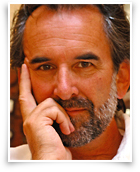
Richard Harvey
connecting psychotherapy and spiritual growth for human awakeningx
Practice in The Way of Sacred Attention: Part 3
The Three Pilgrims
Three pilgrims—they may have been priests or witches in this or another life—wander in the mountains and through the valleys for a long time. Traveling far and wide they sometimes give up hope and plunge into despair.
“There’s just no path,” the first pilgrim says.
“The way is too hard,” says the second.
“If we ever make it, it will be a miracle,” says the third.
Stumbling and faltering, striding and sauntering they go on... and on.
One day on a fresh winter’s morning they come to a certain road. As the stars melt and the sun enters the golden ocean of the numerous days, in the liminal light all three pilgrims are seized with bright certainty.
“This is it! This is the gate!” cries the first pilgrim who falls onto the road in worship.
As they press on the pilgrims look among them and see they number only two.
“Where is our companion?” asks the first pilgrim.
“Our companion stayed lain prone on the road,” answers the other.
“We cannot go back and anyway it would be of no benefit,” says the first pilgrim.
As they walk on, the second pilgrim shakes and tremors, assailed by raptures, occasionally uttering sacred sounds and appearing to dance with arms raised on high. Finally in a mighty swoon of elation the weary traveler pitches into the middle of the road and lies absolutely still.
“At last I am home,” the pilgrim whispers, hesitantly stroking both earth and stones.
The third pilgrim goes on. The journey becomes both harder and more easy. At last the two experiences merge as the road goes on... and on. And there is just the walking… then the footfalls… then the padding, rustling sounds… then merely impressions on the road… and finally… nothing at all.
Many of you know the first pilgrim. Some of you know the second. Who is the third?
Second-stage practice is for those who have completed their personal therapy, come to the end of the Process of Self-Discovery and who have crossed the transformational threshold, a personal act of surrender to their true nature. The practice begins, famously or infamously!, with waiting. A lull is necessary in the forward motion of growth and development in order to allow the transformational process to settle. The organism needs to realign and balance and become gently familiar with the new energetic, emotional, and physical changes that have taken place in a radical way throughout the psycho-physical organism.
Over time the aspirant is likely to experience the last vestiges of childhood ego-patterns and defenses, which I call “loose ends.” This might be considered the final death throes of the childhood ego-self as it comes to terms with its demise. The “historical” work that proceeds from these loose ends should be taken seriously but not considered overly time consuming to deal with and heal.
The central themes of the second stage indicate the focus of practice. First, authenticity. Following the Threshold of Transformation the aspirant is established in a new center, physically, emotionally, and energetically. You might say this gets some getting used to, hence the need for subtle integration and pausing through the waiting period. Released from the past the aspirant now discovers her true nature. She explores her true nature, authenticity, and the new realigned center in relationship with her therapist-guide. Directness, spontaneity, action without explanation and/or excuses, practicing with an internal point of reference, personal presence, dealing with new “powers” of manifestation, relationship, and magnetism are but some of the possible presenting issues that the therapist-guide adapts and offers as personal—not general, one-size-fits-all—exercises and discipline.
Second, compassion. The new dawning of love in the heart of the second-stage aspirant requires stillness, attention, and powerful nurturing. Again the therapist-guide notes and responds from her skill and experience to the client’s needs in recognizing and living from compassion and selfless love in their individual life. Themes for practice include clearing loose ends and subtle desires of the early life-conditioned ego-self, reflecting on impersonal selflessness through the veil of separation and division, self-identification, relating in the world of Two which means with a fading sense of subject, as the temporary adaptive witnessing of arising forms in the matrix of consciousness becomes clearly apprehended, cultivating an acute sense of negotiation, contractual, and conditional love and exchange in relative life relationships, and questioning your own relationships in this regard,
Third, heart-centeredness. This somewhat clumsy sounding term stands for the precious arising of consciousness into the heart or fourth chakra energy center. In the Way of Sacred Attention we consider this not merely a personal act of individual importance but a crucial, collective act which has great significance for present day humanity. Heart-centeredness entails the shedding of the child ego-self in the collective and represents turning away from the present day violent, prejudiced, blaming, guilt-ridden, fearful culture of competitiveness and separation. Centering in the heart requires increased moments of stillness, peace, and tranquility.
The latter period of second-stage practice centers on spiritual preparedness. All the building blocks of the everyday world of thought, emotion and sensation are re-visioned, as are the usual modes of perception and experience. The most full account of this profound work may be found in “The Novena Teachings: Nine Jewels of Sacred Approach” in my book Moksha Dawn.
(“Practice in The Way of Sacred Attention” is a four-part article. Parts 1 and 2 gave an introduction and discussed practice in the first stage of awakening. Part 4 discusses practice in the third stage of awakening.)
Share this article
This article was published on this site in 2019.